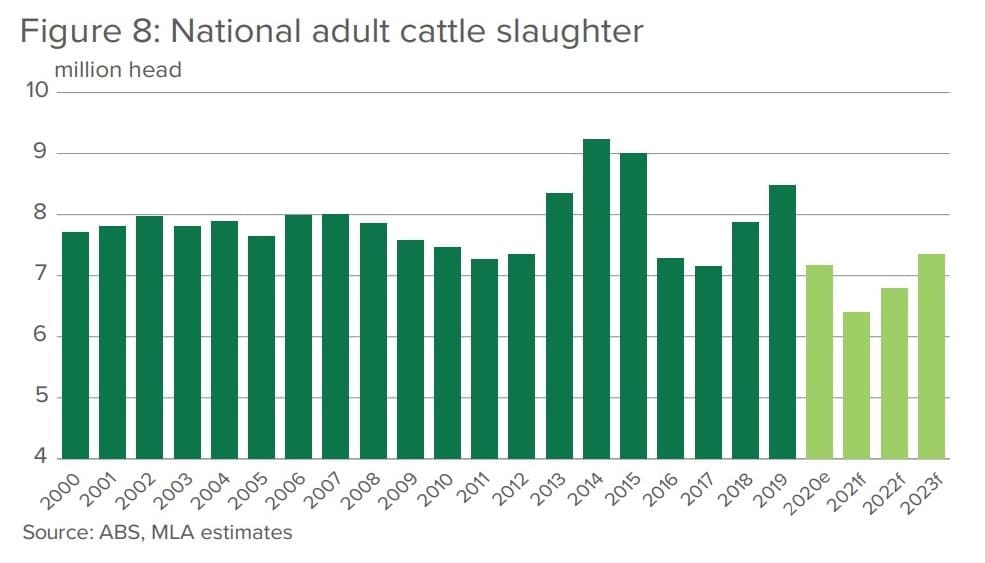
A major reduction in slaughter volumes on the back of significant rainfall in northern Australia over summer has fuelled the prospect of the national cattle herd rebuild intensifying, according to Meat & Livestock Australia’s April quarterly update to the 2021 Cattle Industry Projections.
Historically, cattle slaughter in Australia sits between 7 and 7.9 million head during years of average rainfall. MLA’s forecasts predict that Australian cattle slaughter will not exceed 7 million head until 2023, when it will reach 7.2 million head, at which point the current rebuild will have matured (see graph).
The forecast cattle slaughter for this year of 6.4 million head is the lowest in 36 years.
Despite current cattle prices being at record highs, these prices are not expected to incentivise producers to turn cattle off in large quantities. This is partly due to the fact that the national herd, and in particular the Queensland component, is the lowest it has been in 30 years.
Eastern states’ yardings have fallen by 178,055 head, or 30pc on 2020 levels (year-to-date), with slaughter back by 30pc. These figures demonstrate the impact improved seasonal conditions have created for the processing sector – not only have slaughter numbers fallen, but in saleyards they have to compete with feedlots and restockers for a reduced pool of available cattle.
Direct consignment (OTH) prices are up across the board in 2021, highlighting the difficulty processors are having in sourcing cattle. As a result of the high prices processors are paying, their profit margins have been squeezed, which has only been exacerbated by the appreciating A$.
The need to rebuild the national herd following drought, and current and forecast growth in demand for Australian beef internationally, has intensified the rebuild, MLA’s April update says. Now, many producers are focused on the longer-term outlook of their beef operations by rebuilding herd numbers.
Herd showing early signs of recovery
The cattle herd is predicted to increase by five percent to 25.9 million head this year, close to its size in 2019 before the final year of widespread drought induced de-stocking took place.
MLA market information manager Stephen Bignell said significant rainfall in northern Australia across summer had led to sufficient pasture growth for the up-coming dry season, boosting producer confidence and translating into record high livestock prices.
“More than expected rainfall led to sufficient pasture ahead of the dry season and has encouraged northern producers in particular to restock, driving the market even higher,” Mr Bignell said.
“Summer rainfall encouraged producers to acquire as many cattle as possible before the northern dry season starts – pushing the Eastern Young Cattle Indicator to break the 900c/kg barrier for the first time in history.
Carcase weights are also expected to increase 3pc this year as producers and feedlots utilise the abundance of pasture and cheaper feed which is translating into heavier weights.
Mr Bignell said lower slaughter numbers and reduced supply of cattle through saleyards demonstrated that the herd rebuild is gathering momentum.
“As producers look to retain cattle and take advantage of the improved seasonal conditions, cattle slaughter is expected to fall 11pc this year from 7.2 million head in 2020 to 6.4 million head in 2021,” Mr Bignell said.
“The need to rebuild the national herd following the drought, and the current and forecast growth in demand for Australian beef internationally, has intensified the rebuild. Many producers are focusing on the longer-term outlook of their beef operations and rebuilding herd numbers,” he said.
There were also significant number of producers trading cattle in order to take advantage of current grass levels.
Mr Bignell said the fall in slaughter and production would flow on to export volumes, but demand for Australian beef remained high.
Export volumes are expected to fall 12pc to 1.35 million tonnes carcase weight, however the reduction in exports is a result of cattle supply shrinking and is not linked to demand.
“Demand for Australian beef remains high which can be demonstrated by the price being paid on a per kilo basis,” Mr Bignell said.
In other references in April’s Projections Update, Australian live exports are forecast to fall 26pc this calendar year to 750,000 head, however by 2023 live exports are tipped to rebound 27pc to 950,000 head on the back on increased supply, easing prices and the economic recovery of key trading partners post COVID-19.
Click here to view MLA’s April Industry projections update.
